In September 2009 Richard Welling of Ye Olde Coin Company posted a message on the eBay forums informing the community of a flurry of fake 1934-35 Melbourne Centenary Florins that had been sold on eBay. None of these coins were sold indicating that they were counterfeits and one can only assume the buyers of the coins thought they were real and as such they sold for several hundreds of dollars each. With a few dozen of these fakes selling we are talking about many thousands of dollars being fraudulently gained at the expense of coin collectors. Richard was kind enough to lend us one of these fake florins for comparison with a real florin. We're happy to be able to present to you what we've found.
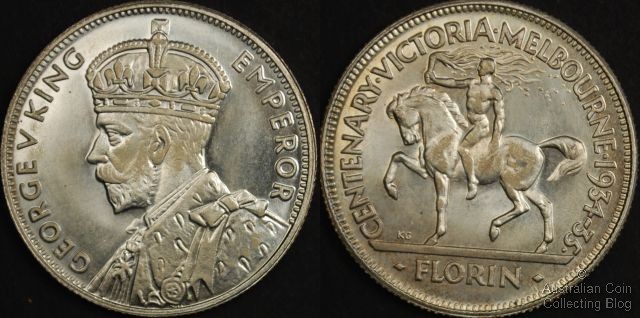
Counterfeit 1934-35 Centenary Florin
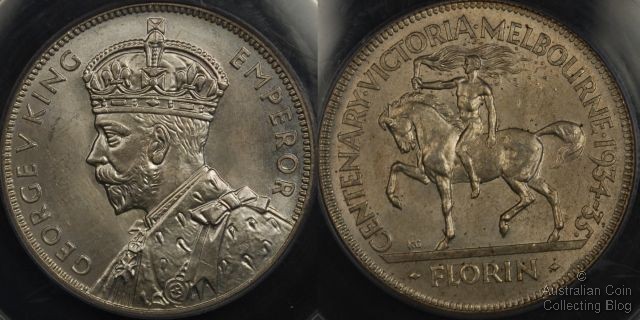
Genuine 1934-35 Centenary Florin
The first thing to be noted about the fake florins is that they are of remarkably good quality and would fool a less experienced collector who wasn't taking too much notice. They are struck rather than cast, and the method used to create the dies was clearly a more advanced technique can the usual investment casting or hand cutting methods. Let's look at how you can pick the real deal from one of these well made fakes.
Weight
An uncirculated florin weighs 11.31g and the fake florin weighs 11.10g. Now 0.21g doesn't sound like a lot but you'd be surprised how little weight a coin loses as it wears. We weighed a mid grade (very fine) florin and the weight was 11.27g, so a worn coin with significant detail missing was just 0.04g lighter! Apparently the fake coin is made from something other than silver to show such a large weight difference.
General Lack of Detail
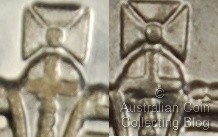
While the fake florin (seen left) does show good detail, when examined closely it shows a coarseness of character that misses out a lot of the fine design features that the real coin exhibits. The image above shows the fake on the left and clearly much of the detail at the top of the king's crown is simply missing or coarsely struck when compared with the real coin.
The King's Cloak
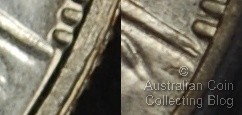
Some of the detail on the back of the King's cloak is simply missing on the counterfeit coin when compared with the real coin. Seen above you can see that the back of the cloak extends all the way to the rim on the real coin whereas the fake coin on the left has the cloak stopping some way short. You can also see that the fold is missing completely from the counterfeit coin.
The King's Nose
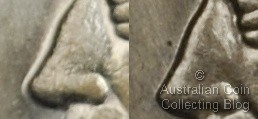
The end of the King's nose is significantly different on the counterfeit florin when comparing it with a genuine coin. Seen above the counterfeit coin on the left shows a rounded nose tip while the real coin shows a clear point.
Legend Lettering

One general observation of the lettering on the fake coin is that it is generally thicker and less refined than that of the real coin. Above you can see the IA dot M from the reverse of the coin. Clearly the lettering is not only less refined than that of the real coin but fish tailing on the bottom of the letters of the genuine article is absent from the fake. Note also that the dot separating the letters is clearly a circle on the fake while the other is clearly an oval.
Missing Design Elements

We managed to identify several missing design elements on the fake coin but these were mostly minor, however some of the streamers around the riders head on the reverse provide a strong indicator between the two coins. On the image above you can clearly see a streamer behind the riders head that is not present on the fake coin. The streamers in front of the riders head are extremely flat and coarse on the fake coin compared with the real coin. Care must be taken with using the flatness of the riders head as an indicator as very poorly struck (but genuine) Centenary Florins can exhibit a rounded and nearly smooth riders head.
General Weakness of Central Strike and Odd Colouration
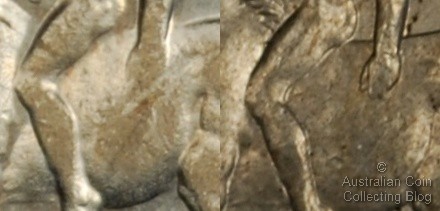
One of the stronger indicators of the fake coin is the general weakness of strike in the central areas of the coin on both sides. Above you can see how the riders hand has nearly disappeared and that the horses stomach is very flat. This image also shows the strange colour that the fake coin shows in areas of weakness. This colour can best be described as very faintly green grey and is very different to any colour we've ever seen on a florin before.
Conclusions
The fact that fake key date coins are now being sold on eBay makes it important that all collectors educate themselves adequately before making large purchases. Hopefully this article has armed you with the information required to determine if the coin you're looking to purchase is one of the recently appearing fakes. If you're at all unsure either buy your coin from a reputable coin dealer or get one that is graded and certified by a reputable third party grading company. Again thanks to Richard Welling of Ye Olde Coin Company for the loan of the fake coin.
Posted by mnemtsas at November 13, 2009 3:25 PM
Subscribe to our Newsletter


